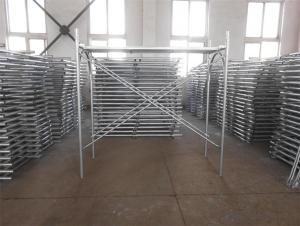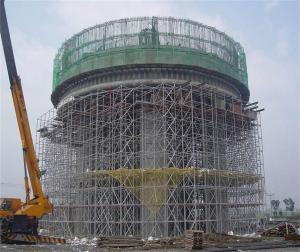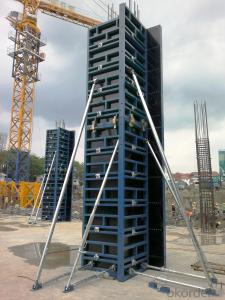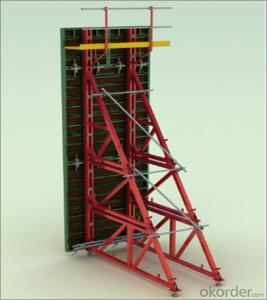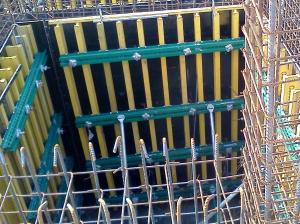Ring lock, Tower Scaffolding with Hot or Cold Galvanized Surface
- Loading Port:
- Shanghai
- Payment Terms:
- TT OR LC
- Min Order Qty:
- 1000 m²
- Supply Capability:
- 100000 m²/month
OKorder Service Pledge
OKorder Financial Service
You Might Also Like
1.Structure of Ring lock Description
Ringlock Scaffolding system is the most popular used Scaffolding system in the world.It will greatly reduce the cost because of the following advantages
Packaging & Delivery
Packaging Details:
Pallet or bag or upon client's request
Delivery Detail:
35days
2.Main Features of Ringlock
It will greatly reduce the cost because of the following advantages
1)Using less pipes
2)Easy to install
3)It can be used again and again for nearly 20years
3.Ring lock product pictures:
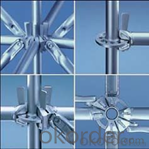
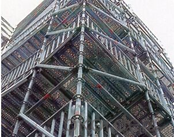
4.Ringlock Product Description
Type: ringlock scaffolding diagonal Brace
specification : Ø48.3×3.20
material:: steel Q235
Finished: Hot DIP galvanized, painted
Diagonal length(m) :Weight(kg)
0.9m * 1.25m 6.28
1.25m * 2.7m 11.45
5.FAQ
We have organized several common questions for our clients,may help you sincerely:
1)How about your company?
CNBM International Corporation, China National Building Materials (Group) Corporation, is one of the largest companies in China building material equipment industry, Our formwork and scaffolding are largely used in both domestic and all over world;
2)How many Scaffolding your company have?
Here comes our 5 types of Scaffolding systems:
- Cup lock Scaffolding(C-Lock Scaffolding)
- Ring lock Scaffolding
-Kwistage Scaffolding
-H-frame Scaffolding
-ID15 Scaffolding Tower, this type Scaffolding is the most widely used in construction, such like bridge.
3)How long can we receive the product after purchase?
Lead time is about 30days after getting the signed PI and deposit.
- Q:Can steel frame formwork be used in areas with limited crane access?
- Yes, steel frame formwork can be used in areas with limited crane access. Unlike traditional formwork systems that require heavy lifting equipment, steel frame formwork is lightweight and easily manageable by a small team of workers. It can be manually lifted and installed without the need for cranes, making it suitable for areas with limited crane access.
- Q:What are the different types of accessories and attachments available for steel frame formwork?
- There are several different types of accessories and attachments available for steel frame formwork. These accessories and attachments are designed to enhance the functionality and efficiency of the formwork system and make the construction process smoother. One of the most common accessories is the adjustable prop. Adjustable props are used to support the formwork system and ensure its stability. These props can be easily adjusted to different heights, allowing for flexibility in construction projects. Another important accessory is the formwork clamp. Formwork clamps are used to securely fasten the formwork panels together, preventing any movement or displacement during the concrete pouring process. Formwork brackets are also commonly used accessories. These brackets are attached to the steel frame formwork and help to support the formwork panels and beams. They provide additional stability and strength to the system. Other accessories include formwork connectors, which are used to connect the formwork panels together, and formwork ties, which are used to secure the formwork system to the structure being constructed. In addition to these accessories, there are also various attachments available for steel frame formwork. One example is the formwork corner, which is used to create sharp corners and angles in the formwork system. This attachment ensures that the formwork system can be adjusted to fit the specific design requirements of a construction project. Another attachment is the formwork bracket arm. This arm is used to extend the reach of the formwork brackets, allowing for greater flexibility in formwork placement. Overall, the different types of accessories and attachments available for steel frame formwork are designed to enhance the stability, flexibility, and functionality of the system. These accessories and attachments help to create a more efficient and effective construction process, resulting in a higher quality finished product.
- Q:How long does it take to install steel frame formwork on a construction site?
- The duration to install steel frame formwork on a construction site varies depending on the size and complexity of the project. However, it typically takes a few days to a couple of weeks for the complete installation of steel frame formwork.
- Q:How does steel frame formwork handle different types of concrete surface repair methods?
- Steel frame formwork is a versatile system that can effectively handle various concrete surface repair methods. The rigid and sturdy nature of the steel frame allows it to withstand the pressures and forces applied during repair processes such as patching, resurfacing, or even shotcrete application. Additionally, the adjustable nature of steel frame formwork enables it to accommodate different repair thicknesses and shapes, ensuring a precise and seamless finish. Overall, steel frame formwork provides a reliable and efficient solution for handling different types of concrete surface repair methods.
- Q:Can steel frame formwork be used for the construction of sports stadiums?
- Yes, steel frame formwork can be used for the construction of sports stadiums. Steel frame formwork provides a strong and durable support system that can withstand the heavy loads and pressures associated with stadium construction. Additionally, the versatility of steel frame formwork allows for the creation of complex shapes and designs required in sports stadiums.
- Q:How does steel frame formwork contribute to the overall sustainability of the construction industry?
- The construction industry benefits from steel frame formwork in various ways, enhancing its overall sustainability. Firstly, steel, being a highly durable material, can withstand the challenges of construction and can be utilized multiple times. Thus, steel frame formwork can be employed for numerous projects, reducing the necessity for new formwork materials and minimizing waste. Moreover, the utilization of steel frame formwork enables efficient construction processes. The presence of steel frames provides a robust and stable support system for concrete during pouring and curing, resulting in structures of superior quality. The precision and accuracy of steel formwork also ensure minimal material wastage, reducing the environmental impact of construction projects. Additionally, steel is a recyclable material, which means that it can be melted down at the end of its lifespan and repurposed to create new steel products. This promotes a circular economy and diminishes the demand for virgin materials, ultimately conserving energy and reducing greenhouse gas emissions associated with the production of new materials. Lastly, steel frame formwork contributes to the sustainability of the construction industry by reducing overall construction time. The incorporation of prefabricated steel formwork systems enables faster and more efficient construction processes, minimizing disturbance to the environment and local communities. In conclusion, steel frame formwork enhances the overall sustainability of the construction industry through its durability, reusability, recyclability, and efficiency. By minimizing waste, conserving resources, and promoting a circular economy, steel formwork assists in mitigating the environmental impact of construction projects and supports the long-term sustainability of the industry.
- Q:Are there any specific considerations for using steel frame formwork in earthquake-prone areas?
- There are specific factors to take into account when using steel frame formwork in earthquake-prone areas. To begin with, it is crucial to ensure that the steel frame formwork is designed and constructed in accordance with the seismic design requirements of the specific area. This entails considering variables such as the anticipated seismic activity level, soil conditions, and prevailing building codes and regulations. The steel frame formwork should possess sufficient strength and rigidity to withstand the seismic forces that may be exerted during an earthquake. This may necessitate the use of thicker steel sections, reinforcement, or additional bracing to enhance the structural integrity and stability of the formwork system. In earthquake-prone areas, establishing a secure connection between the steel frame formwork and the supporting structure is also of utmost importance. This can be achieved through appropriate anchorage and tie-down systems that are designed to resist the lateral forces generated by an earthquake. Proper attention should be given to the detailing and installation of these connections to ensure their effectiveness. Furthermore, it is advisable to utilize high-quality steel and ensure the proper maintenance and inspection of the steel frame formwork. Steel with high tensile strength and good ductility can offer better resistance to the dynamic forces experienced during an earthquake. Regular inspection and maintenance can aid in identifying any potential issues or damage, thereby enabling timely repairs or replacements to preserve the formwork's integrity. Lastly, the safety of workers during the construction process in earthquake-prone areas must be taken into consideration. This may involve implementing additional safety measures, such as providing adequate training on earthquake response and evacuation procedures, ensuring the availability of safe zones during seismic events, and utilizing protective equipment to minimize the risk of injuries. Overall, the use of steel frame formwork in earthquake-prone areas necessitates careful attention to design, construction, connection, material quality, maintenance, and worker safety. It is essential to consult experienced engineers and adhere to local building codes and regulations to ensure the safety and stability of construction in such areas.
- Q:Can steel frame formwork be used for the construction of retail buildings?
- Yes, steel frame formwork can be used for the construction of retail buildings. Steel frame formwork is a versatile and durable construction method that is commonly used in various types of buildings, including retail spaces. It offers several advantages such as high strength, stability, and flexibility in design. Steel frame formwork systems can be easily assembled and dismantled, allowing for efficient construction processes. Additionally, the use of steel frame formwork can result in cost savings due to its reusability, reducing the need for new formwork materials for subsequent projects. Overall, steel frame formwork is a viable option for the construction of retail buildings, providing a reliable and efficient construction solution.
- Q:What are the different types of stripping methods used with steel frame formwork?
- There are several different types of stripping methods used with steel frame formwork, including crane stripping, hydraulic stripping, and manual stripping. Crane stripping involves using a crane to lift and remove the formwork from the concrete structure. Hydraulic stripping utilizes hydraulic jacks to lift and separate the formwork from the concrete. Manual stripping involves manually dismantling and removing the formwork by hand. These methods offer varying degrees of speed, efficiency, and labor requirements depending on the specific project and requirements of the formwork system.
- Q:How does steel frame formwork handle different types of formwork scaffolding?
- Steel frame formwork is a versatile and efficient system that can handle different types of formwork scaffolding effectively. The steel frame formwork consists of sturdy steel panels that are connected together to create a formwork system. These panels provide the necessary support and structure for the concrete during the casting process. When it comes to different types of formwork scaffolding, steel frame formwork can easily accommodate them. Whether it is traditional scaffolding, modular scaffolding, or any other type, the steel frame formwork can be easily integrated and secured to provide a stable and safe working platform. One of the main advantages of steel frame formwork is its adaptability. The steel panels can be easily adjusted and interconnected to meet the specific requirements of different formwork scaffolding systems. This flexibility allows for efficient and precise construction, as the formwork can be easily modified or reconfigured as needed. Moreover, steel frame formwork provides excellent load-bearing capacity, ensuring the safety of workers and materials. The steel panels are designed to withstand heavy loads, making them suitable for supporting various scaffolding systems and providing a secure platform for workers to operate. Additionally, steel frame formwork is highly durable and long-lasting. The steel construction ensures that the formwork can withstand harsh weather conditions and repeated use without compromising its structural integrity. This durability makes it an ideal choice for different types of formwork scaffolding, as it can handle the wear and tear associated with scaffolding systems. In conclusion, steel frame formwork is a reliable and efficient solution for handling different types of formwork scaffolding. Its adaptability, load-bearing capacity, and durability make it an excellent choice for creating a safe and stable working platform for construction projects.
1. Manufacturer Overview |
|
|---|---|
| Location | |
| Year Established | |
| Annual Output Value | |
| Main Markets | |
| Company Certifications | |
2. Manufacturer Certificates |
|
|---|---|
| a) Certification Name | |
| Range | |
| Reference | |
| Validity Period | |
3. Manufacturer Capability |
|
|---|---|
| a)Trade Capacity | |
| Nearest Port | |
| Export Percentage | |
| No.of Employees in Trade Department | |
| Language Spoken: | |
| b)Factory Information | |
| Factory Size: | |
| No. of Production Lines | |
| Contract Manufacturing | |
| Product Price Range | |
Send your message to us
Ring lock, Tower Scaffolding with Hot or Cold Galvanized Surface
- Loading Port:
- Shanghai
- Payment Terms:
- TT OR LC
- Min Order Qty:
- 1000 m²
- Supply Capability:
- 100000 m²/month
OKorder Service Pledge
OKorder Financial Service
Similar products
New products
Hot products
